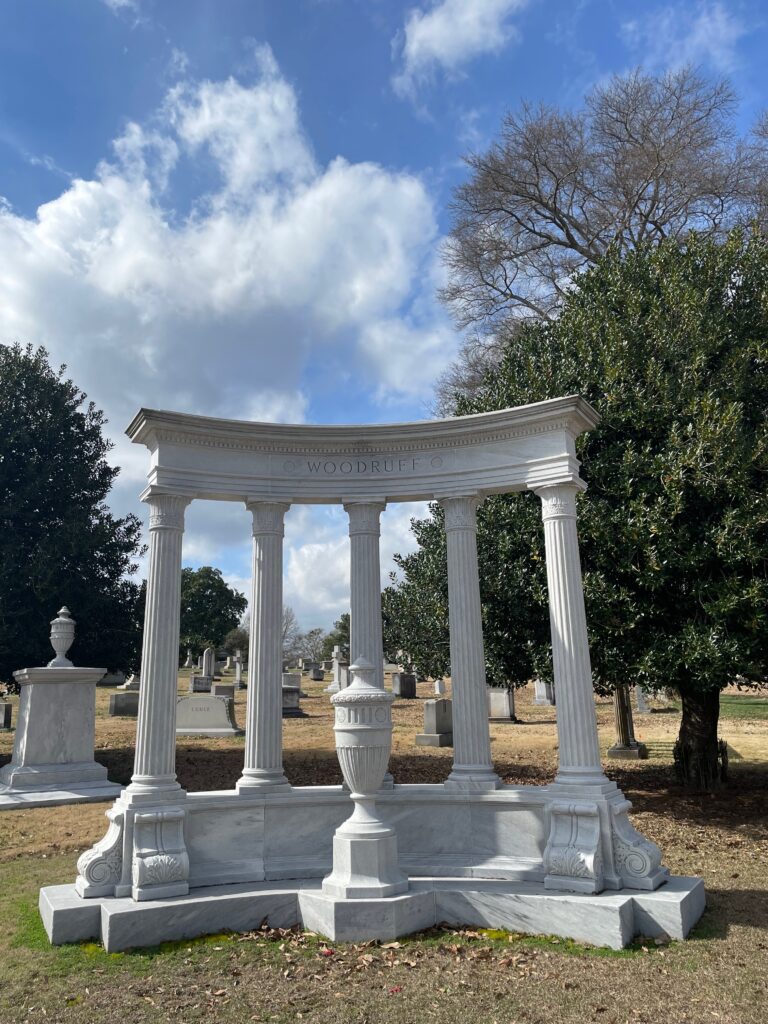Erik Visits an American Grave, Part 1,435
This is the grave of Robert Woodruff.

Born in 1889 in Columbus, Georgia, Woodruff grew up rich. Daddy Woodruff was one of the owners of Coca-Cola after he and his fellow investors bought it from Asa Candler in 1919. But even before that, Woodruff’s father was a prominent Atlanta businessman.
Woodruff was a terrible student. His father sent him to a military academy but it didn’t help. He flunked out of both Georgia Tech and Emory. Annoyed, his father tried to get his lackluster son a job at Coke, but the boy didn’t want that. He wanted to hoe his own row. He got a job at a foundry, just doing regular labor. But look, it didn’t take long for the bosses to realize who the new kid’s father was. He rose up that company pretty fast, largely because of his father. Woodruff would later play this as a bootstraps story, but this was totally bogus. I mean, he did start by shoveling sand, yes, but I wonder why the other sand shovelers didn’t later become multi-millionaires? Hmmmm….
Anyway, Woodruff worked a ton of jobs over the next several years, some with the help of his father, others on his own. By the mid 1910s, he was vice president of White Motor Company in Cleveland, one of many early car companies that later failed. In World War I, he was in the U.S. Ordinance Department, where he got the government to buy a White truck that made the company a ton of money. In fact, the company later moved into large trucks and existed all the way until 1980.
But Woodruff ended up back at Coke. Why? Daddy. In fact, it was Daddy Woodruff’s attempt to smooth things over with his son, as they never had a good relationship. So to try and build a relationship, pop offered his boy…the presidency of the world’s largest soda company. Meritocracy! This was in 1923. He would hold that position for the next 32 years, though he would remain on the Board of Directors for the rest of his life. Effectively, he ran the company until 1985. He held so much stock that while after 1955 there were other presidents, the real chief was Woodruff. He had a couple of strokes in the early 70s that slowed him down, but he remained active on the board.
What this meant is that Woodruff ran Coca-Cola during its massive global expansion, which began in earnest in 1926. That worked brilliantly and Coke was almost a representative of America by the end of World War II. He stated at the beginning of American entry into the war that he “would see that every man in uniform gets a bottle of Coca-Cola for five cents wherever he is and whatever it costs.” Playing that patriotic card, Woodruff got the Roosevelt administration to waive sugar rationing for his company and he could produce as much Coke as he wanted. The military played up Coke as America and it became a little sweet slice of caffeinated home. He also had the company introduce things such as the six-pack carton and the famous Coke coolers so people in stores could grab a cold one. He also helped originate corporate sponsorship, making a big deal of sending Cokes with the U.S. Olympics Team to Amsterdam for the 1928 games.
Today, you can find it basically anywhere in the world at any given time. Even before World War II, Woodruff had established bottling plants everywhere from France to Guatemala. Back when I drank soda, this was something I liked, but now, not having had a soda in almost 2 years, I wonder what the heck I was thinking. Addiction I guess, I don’t know. Minor thing to be addicted to in the bigger scheme of things, but you add that minor thing by a couple of billion people and that’s a lot of money going into Coke coffers. Still, a Coke with some tacos in Mexico, I mean that’s almost iconic in my mind, even though I don’t drink it anymore. He also was the one who made a big mystical thing about the Coke formula, putting the recipe into a bank vault and only allowing a tiny number of people to see it. He also engaged in the kind of corporate consolidation that has become so common today. Coke bought Minute Maid in the 60s, Columbia Pictures in the 80s, all sorts of other big companies over the years.
All this meant Woodruff got to spend his later years as the big man philanthropist, which is almost always about making the boss feel good about himself and all the things he did to earn that money, which are often of questionable moral value. He split his personal time between his fancy New York apartment and his 37,000 acre plantation and hunting reserve in early Georgia. In fact, Woodruff saw himself as a pre-Civil War plantation owner, which isn’t that surprising given that he was also buddies with Ty Cobb, himself a big time Coke investor and Woodruff’s hunting buddy. Gross though.
Woodruff died in 1985. He was 95 years old.
Robert Woodruff is buried in this subtle monument in Westview Cemetery, Atlanta, Georgia.
This has been a soda-oriented week in the grave series. Total coincidence, I assure you. If you would like to see this series visit other sodamongers, you can donate to cover the required expenses here. Edward Charles Edmond Barq, inventor of the eponymous root beer, is in Biloxi, Mississippi, and Charles Hires, creator of his own root beer even before Barq, is in Bala Cynwyd, Pennsylvania. Previous posts in this series are archived here and here.


